NSW bushfires: Town of Bobin in ruins after blaze claims 20 homes
The devastated village of Bobin is attempting to rise from the ashes after a firestorm which one helpless witness linkened to “the devil himself” storming down the mountain.
NSW
Don't miss out on the headlines from NSW. Followed categories will be added to My News.
TALES of heroism and heartbreak are emerging from the shattered NSW town where almost 20 homes were reduced to ash by a firestorm likened by witnesses to “the devil himself” coming down from the mountains.
The tiny town of Bobin, on the mid-north coast, is now calling for donations to rebuild from the carnage after the Rumba fire claimed 18 homes and left 73,000 hectares of scorched earth in its wake.
The blaze’s perimeter is now more than 600 kilometres long — twice the distance between Sydney and Canberra — and growing.

The home of John Earl and his partner Bobby McCorkindale was among those lost in the initial barrage.
Mr Earl, like other locals, had been watching the fire burn in the hilly countryside over the ridges for weeks.
But on November 8, he realised how close to danger he really was.
“I went out and thought ‘it’s closer than I thought’,” he said. “In just ten minutes everything was just red. It was like the devil himself was putting his bloody head over the ridge.”
Ms McCorkindale was in New Zealand, desperately searching for updates as the remote valley burned.
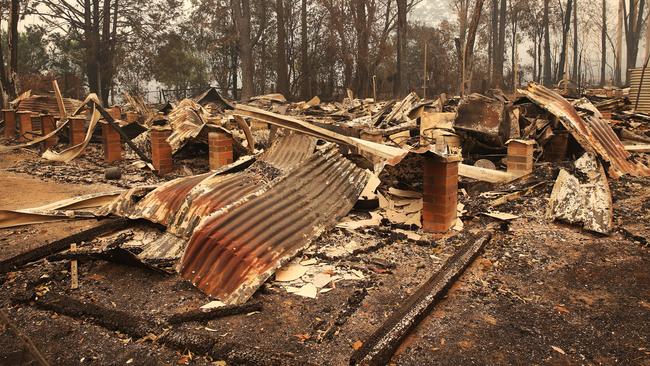
Meanwhile, Mr Earl was armed with only water pumps and garden hoses when flames “60 to 70 feet high” tore through the tinder-dry bush toward his home. Flaming trees blocked the exit from his property and he realised there was no escape.
“I wasn’t thinking about if or how I might die,” he said.
“When I knew I couldn’t save anything, and knew I couldn’t get out, I just laid on the ground.”
The exhausted 67-year-old lay in the dirt behind his ute for three hours as his home was reduced to rubble.
He survived and made it to a friend’s home.
But he would spend the next five days working to save that one as well.
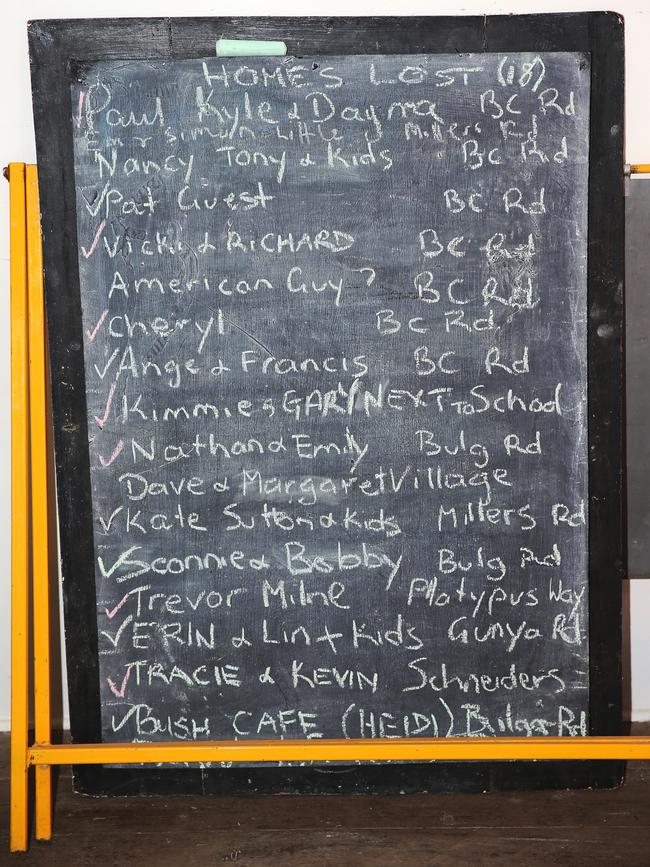
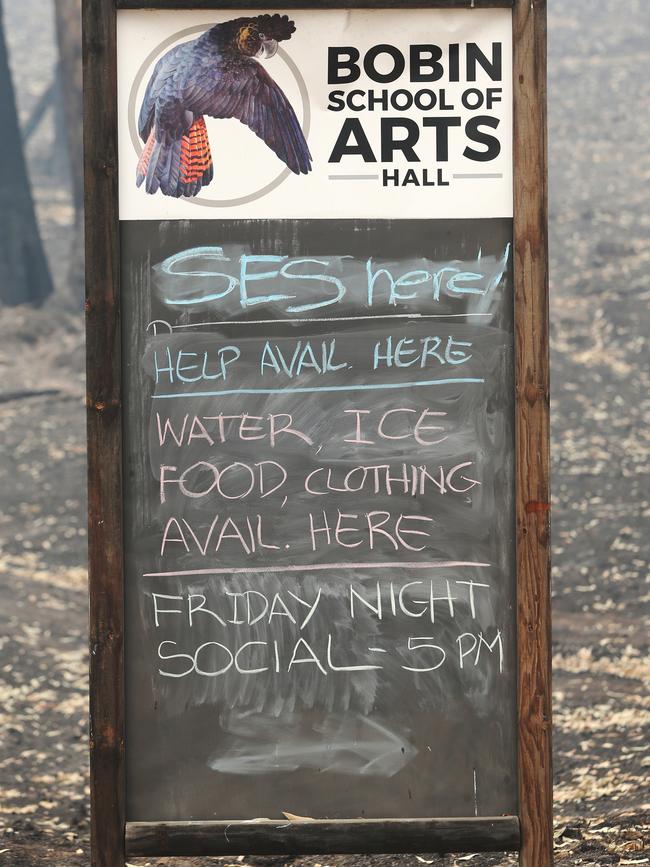
The Bobin hall and evacuation centre is across the road from the public school, which was also almost entirely razed.
There were already concerns in the town that the only school would close due to low numbers; now there are fears the classroom and admin building will not be rebuilt.
Former student and former Bobin resident Alice Guest broke down in tears looking at the ruins.
Her childhood home, where her father Pat lived, was also destroyed.
“When the news came that Bobin was burning, my dad tried to get out here,” Ms Guest said. “At one stage he was turned back at the barricades and called me. He said ‘I can see flames, we’ve lost our house‘.”
“My roots are here. The loss. The loss.”

The destroyed school buildings have been sprayed with a blue bonding agent to contain any straying toxic materials like asbestos.
It’s the only colour amid the smoke-grey sky and miles of blackened bushland.
Ms Guest’s own home remains under threat at Upper Lansdowne, one of the current heads of the fire.
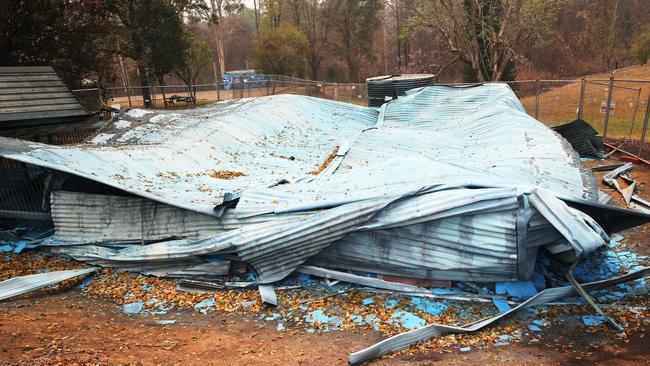
Sandra Zielke, who is running the evacuation centre in town, is also behind a fundraiser — Build Bobin Back.
It has raised more than $7000.
Like Mr Guest, she had been stopped a barricade trying to reach her family in Bobin — but her home was saved.
“I was numb as anything watching the fire take over the whole mountain.”
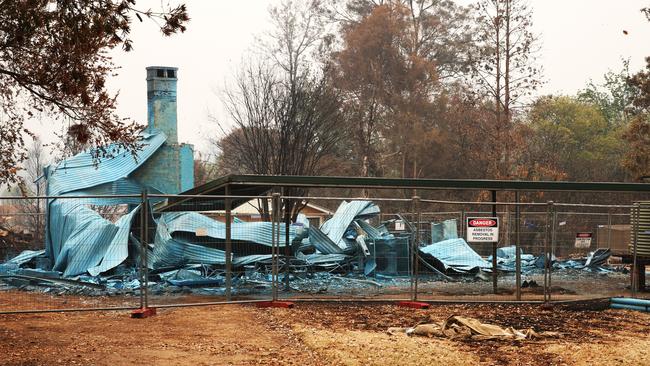
Bobin’s evacuation centre has a chalk board with the names of residents who have lost their homes and records their accommodation status.
Ms Zielke has asked about a dozen of the residents who have lost homes about insurance. Only five have been covered, she said.
Local rotary clubs are also raising money for those affected by the mid north coast bushfires.
So far tens of thousands of dollars have been donated.
EXPERTS DISMISS CLIMATE CHANGE IN FIRE DANGER
Climate change is not to blame for the latest outbreak of bushfires, say a number of experts who reject claims global warming is behind the latest outbreaks or that the current blazes are “unprecedented”.
Several retired Australian fire chiefs, including former NSW Fire and Rescue commissioner and current Climate Council member Greg Mullins, have claimed Australia’s rising emissions are causing “megafires” that can’t be put out.
But Volunteer Fire Fighters Association president Mick Holton, who has been fighting bushfires for 40 years, says fuel loads are the critical issue and green tape, along with changing attitudes, have stifled hazard reduction.

“Our view is pretty simple — less fuel means less fire,” he said. “Climate change may well impact on our fire behaviour but we should not be blaming climate change for these big fires.
“We’re in a terrible situation because we’ve let it get out of control. We’ve had bad droughts before, we forget about history. The real enemy here is the fuel loads.”
He said NSW had 22 million hectares of bushfire-prone land but less than one per cent had undergone hazard reduction. “But the Black Saturday Royal Commission in Victoria recommend at least five per cent per annum,” he said. “It has been building up over decades. Our association believes the answer is to also reduce a lot of the red tape.”

Australian geologist Professor Ian Plimer says it is a “fraud” to claim we are living in “unprecedented” time of climate emergency, and people making those claims should check the history of the planet.
“In eastern Australia, the best way to look at this is to look at lake sediment ... which show layers where you have the charcoal in there — this is saying we have had periods of massive bushfires,” he said.
Retired meteorologist William Robert Kininmonth said bushfires were a part of the Australian landscape and drought episodes were a part of the natural variability of our environment.
TEACHING LESSONS IN SURVIVAL
More teachers at schools in bushfire-prone areas should be given basic fire training to help boost the safety of themselves and students across the state.
That’s the view of the NSW Secondary Principals’ Council, whose acting President Craig Petersen has more than 33 years’ experience as a firefighter with the Rural Fire Service and Fire and Rescue.
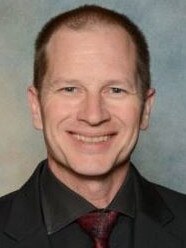
Currently more than 1500 NSW schoolteachers take part in emergency simulation training and workshops ahead of the bushfire season each year. However, Mr Petersen said greater knowledge among teachers would improve safety standards even further.
Mr Petersen also said it “makes perfect sense” for schools across NSW to be used as fire evacuation centres.
A NSW Department of Education spokesman said the preparation and effort from emergency services and education staff over the past week “is why all students remained safe in incredibly challenging circumstances”.
